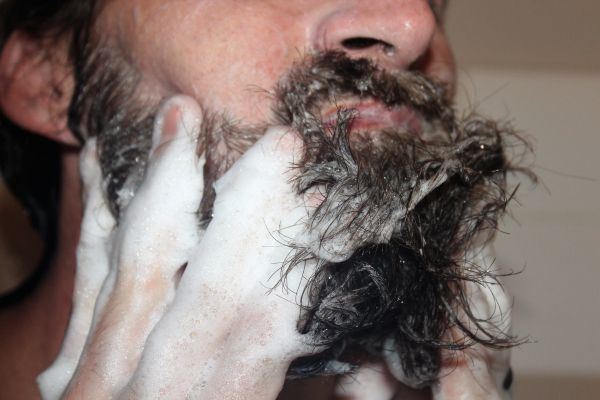How to Prevent and Treat Beard Dandruff: Effective Tips and Solutions
Apr 27, 2025 | By Maria Eliza Pineda

Having beard dandruff is one of the most common issues faced by men who grow facial hair. Aside from the uncomfortable itching, it also affects the appearance of the beard and lowers self-confidence. Fortunately, there are many beard dandruff prevention treatments that can be done at home from proper beard grooming techniques to using natural and effective products.
What Causes Beard Dandruff?
Similar to scalp dandruff, beard dandruff can be caused by various factors such as dry skin, seborrheic dermatitis, or fungal infections. Poor beard hygiene is also one of the main reasons flakes and itchiness develop under the beard.
Cold weather, frequent hot showers, and lack of exfoliation can lead to dry skin and buildup of dead skin cells. Additionally, a poor diet and excessive consumption of processed foods can worsen the condition.
Cleaning with the Right Beard Shampoo
Regularly washing your beard with a proper beard shampoo is a crucial step in preventing dandruff. Water or regular facial soap isn't enough and can sometimes irritate the skin. Choose a gentle beard shampoo specifically formulated for facial hair to effectively remove dirt, oil, and product buildup from your hair and skin. Consistent use helps prevent dead skin buildup and keeps pores clean which is often the source of irritation.
Moisturizing with Beard Oil
Keeping the skin under your beard hydrated is essential to preventing flakes. Using beard oil is an effective way to soften the hair and keep the skin moisturized. In addition to its aesthetic benefits, beard oil helps reduce itching and dry skin.
The best time to apply it is right after showering, when your skin is still damp, to help with better absorption. Massage it deeply into the skin under your beard to ensure it penetrates, not just coats the hair.
Exfoliating the Skin Beneath Your Beard

Exfoliation is often overlooked in beard care routines. By removing dead skin cells, you prevent buildup that can lead to dandruff. You can use a facial scrub or a beard brush with natural bristles like a boar bristle brush. Exfoliating once or twice a week is recommended to avoid skin irritation. This also improves blood circulation and promotes healthier hair growth.
Using Anti-Dandruff Shampoos
For more severe beard dandruff, it may be necessary to use an anti-dandruff shampoo with ingredients like selenium sulfide or pyrithione zinc. These have antifungal and antibacterial properties that help fight off microbes and fungi causing dandruff. Make sure the product is safe for use on the face and not too harsh, to avoid dryness or irritation.
Applying Topical Treatments
If the beard dandruff is caused by seborrheic dermatitis or a more serious skin condition, topical treatments may be needed. These include antifungal creams or mild corticosteroids, usually prescribed by a dermatologist. Do not use these products without proper medical guidance, as they may cause further irritation or side effects on facial skin.
Using Natural Remedies
For those who prefer a natural approach, there are several home remedies you can try. Tea tree oil is known for its antifungal and antibacterial properties that help fight microbes and fungi.
Another popular remedy is aloe vera gel, which provides moisture and a soothing effect on the skin. You can also use diluted apple cider vinegar as a beard cleanser to restore the skin’s pH balance and fight dandruff-causing fungi.
Maintaining a Healthy Beard Grooming Routine

Having a consistent beard grooming routine is key to preventing dandruff in the long term. Make it a habit to wash your beard 2–3 times per week with beard shampoo and conditioner. After showering, apply beard oil to keep the skin moisturized.
Regular trimming is also important to prevent split ends and reduce itchiness. A well-groomed beard is not only better looking, but also more comfortable to wear.
Eating a Nutritious Diet for a Healthier Beard
Proper beard care isn’t just about external maintenance—it starts from within. Make sure your diet is balanced and rich in nutrients such as omega-3 fatty acids, zinc, and biotin, which are essential for skin and hair health. Avoid excessive intake of processed food and drink plenty of water to keep your skin hydrated.
Frequently Asked Questions
What causes beard dandruff?
Beard dandruff can be caused by dry skin, seborrheic dermatitis, fungal infections, or lack of proper beard care.
Can beard oil help prevent dandruff?
Regular use of beard oil helps keep the skin hydrated and prevents dryness that leads to flaking. It also helps nourish your beard hairs and keeps the beard soft and manageable.
How often should I wash my beard?
It’s recommended to wash your beard 2–3 times a week to avoid over-drying the skin.
Are there natural remedies for beard dandruff?
Natural solutions like tea tree oil, aloe vera, and apple cider vinegar can help reduce dandruff.
Does diet affect beard dandruff?
Most of the nutrition hair gets - whether that’s hair on the top of your head or your face - comes from your diet. An unbalanced diet can lead to dry skin and unhealthy beard growth no matter how many hair products you use, it will always come down to what you eat on a daily basis.
Well-Groomed and Dandruff-Free
Beard dandruff is a common problem, but it's easily manageable with the right knowledge and commitment to beard care. With a proper wash routine, the use of beard oil, regular exfoliation, and a healthy diet, you can achieve a clean, flake-free, and healthy beard. If the condition persists despite trying these steps, it’s best to consult a dermatologist for more appropriate treatment.




